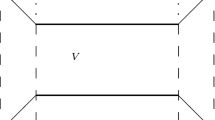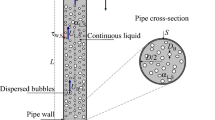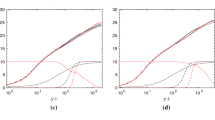Abstract
This chapter addresses the stable and linearly unstable Drift-Flux Model (DFM). The well-known Drift-Flux wave propagation equation is derived applying the kinematic condition to the FFM of Chap. 5. This removes the SWT and KH instabilities but preserves the material wave speed and nonlinear evolution of the waves, allowing the analysis of several stable problems of engineering interest, e.g., level swell, drainage, and the propagation of material discontinuities. Then the fixed flux approximation is removed and the DFM mixture momentum equation of Ishii and Hibiki (Thermo-fluid dynamics of two-phase flow, Springer, 2006) that incorporates the drift-flux assumption, i.e., the kinematic equilibrium condition, is introduced. This represents the counterpart to the fixed flux assumption of earlier chapters because it fixes the relative velocity whereas the total flux, j, is now allowed to fluctuate. To illustrate what this difference implies, the DFM is applied to the linear analysis of two global instabilities for boiling channels: the flow excursion and the density wave instability.
The DFM is the optimal TFM approximation to analyze global material wave instabilities, if the flow regime is stable, precisely because it precludes the local instabilities specifically addressed by the FFM. Thus, FFM and DFM are natural counterparts that render a broad picture of TFM stability. This wide stability spectrum is one reason why the TFM is so versatile for engineering two-phase flow applications.
Access this chapter
Tax calculation will be finalised at checkout
Purchases are for personal use only
Similar content being viewed by others
References
Achard, J.-L., Drew, D. A., & Lahey, R. T., Jr. (1981). The effect of gravity and friction on the stability of boiling flow in a channel. Chemical Engineering Communications, 11, 59–79.
Achard, J.-L., Drew, D. A., & Lahey, R. T., Jr. (1985). The analysis of nonlinear density-wave oscillations in boiling channels. Journal of Fluid Mechanics, 166, 213–232.
Bernier, R. J. N. (1982). Unsteady two-phase flow instrumentation and measurement. Ph.D. 533 Thesis, California Institute of Technology, Pasadena, CA.
Clausse, A., Delmastro, D., & Juanico, L. (1996). A simple delay model for density-wave oscillations. Latin American Journal of Applied Research, 26, 185–191.
Delmastro, D., Juanico, L., & Clausse, A. (2001). A delay theory for boiling flow stability analysis. International Journal of Multiphase Flow, 27, 657–671.
Hewitt, G. F. (1982). Void fraction. In G. Hetsroni (Ed.), Handbook of multiphase systems. New York: McGraw-Hill.
Ishii, M. (1971). Thermally induced flow instabilities in two-phase thermal equilibrium. Ph.D. Thesis, School of Mechanical Engineering, Georgia Institute of Technology.
Ishii, M. (1975). Thermo-fluid dynamic theory of two-phase flow (Collection de la Direction des Etudes et Researches d’Electricite de France). Paris, France: Eyrolles.
Ishii, M. (1977). One-dimensional drift flux model and constitutive equations for relative motion between phases in various two-phase flow regimes (Argonne National Lab. Report, ANL-77-47).
Ishii, M., & Hibiki, T. (2006). Thermo-fluid dynamics of two-phase flow. New York: Springer.
Lahey, R. T., Jr., & Moody, F. J. (1977). The thermal-hydraulics of a boiling water nuclear reactor. La Grange Park: American Nuclear Society.
Ledinegg, M. (1938). Instability of flow during natural and forced circulation. Die Wärme, 61(8), 891–898.
Miles, G. D., Shledovsky, L., & Ross, J. (1943). Journal of Physical Chemistry, 49, 93.
Rizwan-Uddin, & Dorning, J. J. (1986). Some nonlinear dynamics of a heated channel. Nuclear Engineering and Design, 93, 1–14.
Ruspini, L. C., Marcel, C. P., & Clausse, A. (2014). Two-phase flow instabilities: A review. International Journal of Heat and Mass Transfer, 71, 521–548.
Wallis, G. B. (1969). One-dimensional two-phase flow. New York: McGraw-Hill.
Wallis, G. (2013). Novak Zuber and the drift flux model. Multiphase Science and Technology, 25(2–4), 107–112.
Wallis, G. B., & Heasley, J. H. (1961, August). Oscillations in two phase flow systems. Journal of Heat Transfer, 83, 363–369.
Wulff, W. (1985, June). Kinematics of two-phase mixture level motion in BWR pressure vessels. In Proceedings of Specialists Meeting on Small-Break LOCA Analysis in LWRs, Pisa, Italy.
Zuber, N., & Findlay, J. A. (1965). Average volumetric concentration in two-phase flow systems. Journal of Heat Transfer, 9, 453–468.
Zuber, N., & Staub, F. W. (1967). An analytical investigation of the transient response of the volumetric concentration in a boiling forced-flow system. Nuclear Science and Engineering, 30, 268–278.
Author information
Authors and Affiliations
Rights and permissions
Copyright information
© 2017 Springer International Publishing Switzerland
About this chapter
Cite this chapter
de Bertodano, M.L., Fullmer, W., Clausse, A., Ransom, V.H. (2017). Drift-Flux Model. In: Two-Fluid Model Stability, Simulation and Chaos. Springer, Cham. https://doi.org/10.1007/978-3-319-44968-5_6
Download citation
DOI: https://doi.org/10.1007/978-3-319-44968-5_6
Published:
Publisher Name: Springer, Cham
Print ISBN: 978-3-319-44967-8
Online ISBN: 978-3-319-44968-5
eBook Packages: EngineeringEngineering (R0)




